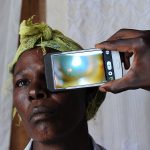This blog post is part of PHR’s Tech & Human Rights Blog Series. The series is meant to highlight the intersection between technology and human rights, and examine the increasing role that technology can play in advancing human rights around the world.
The lights flickered once, twice, and then cut out completely. Members of our party who have spent several years – some their entire lives – in the Democratic Republic of the Congo (DRC) were unfazed and continued to speak without interruption. They waited patiently for the lights to return so they could continue eating. We were having dinner in Bukavu in January 2015, and it was my first visit to the DRC as part of a team gathering feedback on a new version of MediCapt –the mobile application under development by Physicians for Human Rights (PHR), meant to help clinicians more effectively collect, document, and preserve forensic medical evidence of sexual violence to support local prosecutions of such crimes.
Power cuts are a daily reality of working in low-resourced, conflict-affected countries like the DRC, and are only one of many such hurdles. While daunting, these challenges are not insurmountable. Various technologies are helping human rights activists and organizations overcome the logistical and political difficulties one faces when working in remote, conflict-affected areas.
At first, resource-related obstacles appear overwhelming. In the DRC, inevitable power outages are matched by similarly unpredictable Wi-Fi coverage. Outside of urban areas, electricity access is often completely unavailable. Even where electricity and Wi-Fi are stable, challenges of another, more political, nature can emerge. While I was in the DRC in January, all internet access originating in the country had been shut down by the government in the midst of protests around upcoming elections. In fact, internet shutdowns have become a ubiquitous tool for governmental control, used by Bashar al-Assad’s regime in Syria and by Hosni Mubarak in Egypt during the Arab Spring. Thus, any technology that relies on internet connection must take both the possible political and infrastructural barriers into consideration.
Despite such challenges, organizations are finding ways to harness advances in technology to circumvent limitations. For example, developments in solar technology can be instrumental in overcoming low electricity levels. Companies like Greenlight Planet offer ever-better ways to generate and store solar energy, while specifically targeting the needs of low-resourced areas. New devices, such as a compact portable ultrasound created by GE Healthcare, are specifically designed for use with batteries that can be solar-powered and ones that have extended battery life. So when an organization like PHR needs stable electricity to conduct human rights trainings in remote parts of Africa, solar power can help ensure success.
Similarly, organizations like Endaga are developing entrepreneurial ways to improve internet connectivity through the creation of small-scale wireless networks. Strong internet connections can help ensure that doctors who use MediCapt are able to securely document signs of sexual violence in their patients. Other technologies avoid the need for internet connection by using SMS-based systems, such as a program piloted in Kenya to monitor the status of patients diagnosed with HIV/AIDS. This model is useful in places where phone coverage is more prevalent than internet access.
People around the world have also risen to the challenge of overcoming governmental restrictions on technology use. In Hong Kong, for example, protesters used mesh networking to exchange messages even after cell phone service had been cut off. In countries exercising internet censorship, such as China and Iran, virtual private networks (VPNs) have long been a circumvention tool. And while governments are adapting their own practices to address circumvention techniques, the tools keep improving. The recently-released FireTweet app utilizes a peer-to-peer network rather than the traditional VPN structure, making it more difficult for governments to identify and block access.
These creative technologies and developments represent the broad range of solutions being used to address the inherent challenges that human rights organizations face by working in remote and politically volatile environments. Each provides a unique response to the hurdles present in various settings. These advances are essential to the success of tools like PHR’s MediCapt and are the key to allowing technology to significantly advance human rights around the globe.

